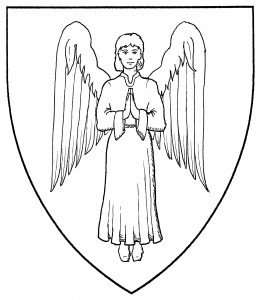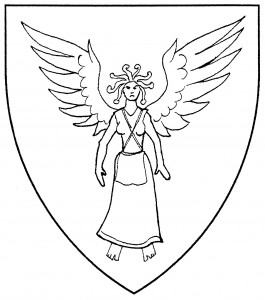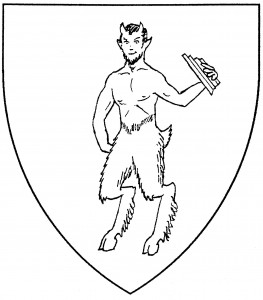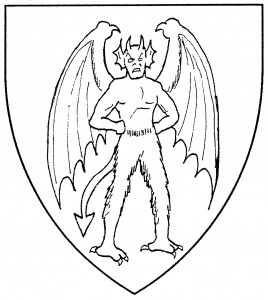This category of monster consists of those whose forms are basically human, but with additions or mutations. There does not seem to be a default posture common to all of them. When blazoned “proper”, period practice would assume the human parts to be Caucasian (pink or white) unless otherwise specified; Society blazon had once followed this, but is now more inclusive. The human portions of these monsters now follow the same Society blazon conventions as human figures (q.v.).
The “angel” is a human with a pair of wings on its back; it’s a period charge, found in the canting arms of von Engelhoffer c.1450 [Ingeram 140; also Siebmacher 97]. Its default posture is statant affronty, wings displayed (frequently displayed inverted) [Parker 10]. A specific variant of this is the Archangel Michael, so named in blazon: winged and haloed, but armed and armor-clad (and frequently depicted vanquishing a dragon underfoot).
A Society variant of the angel is the “standing seraph”, with six wings: two with tips up, two with tips down, and two covering the body. Like the angel, it’s statant affronty by default. (These are not to be confused with the “cherub” and the “seraph”, which are winged heads; these may be found under (human) head.)
The “fury” is a creature from Greek myth, a winged woman with serpents for hair. It appears to be unique to Society heraldry.
The “satyr” or “pan” is also from Greek myth; it combines the torso of a human with the hindquarters of a goat. It is horned, and may be shown playing a panpipe. The satyr is found as an heraldic charge in the arms of Arcos, c.1540 [Nobreza xl]; though cantingly armed with a bow, and blazoned as a “sagittary”, the creature has two feet, not four, and they are cloven.
The “troll” is a charge from Scandinavian heraldry, found in the canting arms of Trolle, c.1440 [Raneke 412-413]. (It is sometimes, erroneously, blazoned a “devil” outside Scandinavia.) The heraldic troll is distinguished by having no head: its face is embedded in its torso. It has clawed hands and feet, and a tail; by default, it is shown passant, with the head in full view, and one hand holding the tail.
Finally, there is the “demon” or “gargoyle”, like the satyr in having a beast’s hindquarters, but with the addition of bat-wings, a barbed tail, and sometimes talons. Unfortunately, its best-known heraldic use, in the arms of the City of Brussels, dates only to the early 19th Century. Demons depicted in period books of hours vary too widely in appearance to be reproducible; therefore, pending evidence of their use in period armory, demons are no longer permitted in Society armory.
For specific entries of other monsters with human parts, see: centaur, harpy, lamia, man-serpent, manticore, man-tyger, mermaid, silkie, sphinx, tarasque.
The Baron of the Angels bears: Gules, a standing seraph affronty proper, winged Or, haloed of a laurel wreath proper.
The Canton of Trollhaven bears: Argent, a troll within a laurel wreath vert and on a chief azure a three-arched bridge Or.
Francesca d’Angelo le Noir bears: Argent, a brunette angel proper, winged and vested sable.
Rhys Gethin bears: Vert semy-de-lys Or, the Archangel Michael argent haloed Or.
Jason the Blue bears: Or, a four-armed demon azure, winged gules.
Marta as-tu Mika-Mysliwy bears: Per chevron vert and Or, in base a satyr dancing and piping proper.
Megara di Alessandra bears: Sable, a Fury rampant affronty, sinister hand lowered, proper vested argent, winged Or, maintaining in the dexter hand a torch bendwise sinister enflamed proper.





